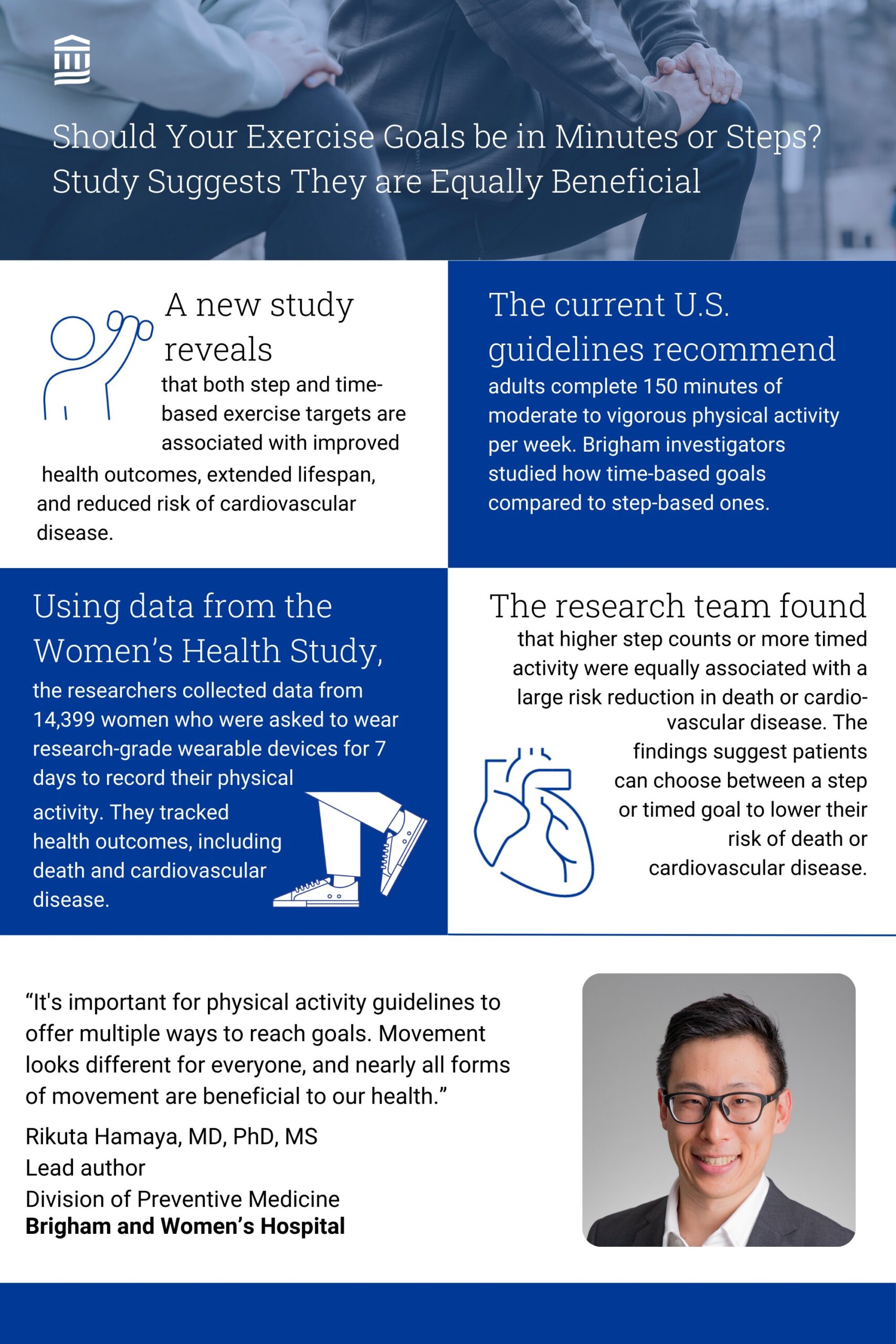Health
Research shows that both step- and time-based training goals are equally beneficial

New research from researchers at Brigham and Women’s Hospital shows that both step- and time-based exercise goals are equally associated with better health outcomes, longer life and a reduced risk of cardiovascular disease. Credit: Brigham and Women’s Hospital
In the age of smartwatches, monitoring step counts has never been easier, but current physical activity guidelines don’t explicitly recommend specific step counts for health. A new study from researchers at Brigham and Women’s Hospital, a founding partner of Mass General Brigham, suggests that both step- and time-based exercise goals are equally associated with lower risks of premature death and cardiovascular disease. So whether someone chooses a time or step goal may not be as important as choosing a goal that suits personal preferences.
The results are published in an article titled “Time vs. Step-Based Physical Activity Metrics for Health.” JAMA Internal Medicine.
Physical activity reduces the risk of chronic diseases and infections and promotes longevity. The current US guidelineslast updated in 2018, recommends that adults engage in at least 150 minutes of moderate to vigorous physical activity (e.g., brisk walking) or 75 minutes of vigorous activity (e.g., jogging) per week.
At the time, most existing evidence on health benefits came from studies in which participants self-reported their physical activity. There were few data points on the relationship between steps and health.
Fast forward to the present: With wearables becoming ubiquitous, step counts are now a popular metric on many fitness tracking platforms. How do time-based goals compare to step-based goals? Researchers tried to answer this question.
“We recognized that existing physical activity guidelines primarily focus on duration and intensity of activity, but lack step-based recommendations,” said lead author Rikuta Hamaya, MD, Ph.D., MS, investigator in the Division of Preventive Medicine at BWH.
“As more and more people use smartwatches to track their steps and overall health, we saw how important it is to determine how step-based measurements compare to time-based goals as they relate to health outcomes: is one better than the other? Others?”
For this study, researchers collected data from 14,399 women participating in the Women’s Health Study who were healthy (free of cardiovascular disease and cancer).
Between 2011 and 2015, participants aged 62 and older were asked to wear research-grade wearables for seven consecutive days to record their physical activity levels, only removing the devices for sleep or water-related activities.
Annual questionnaires were administered throughout the study period to assess health outcomes of interest, specifically death from any cause and cardiovascular disease. Researchers followed the participants until the end of 2022.
At the time the device was worn, researchers found that participants engaged in an average of 62 minutes of moderate to vigorous physical activity per week and took an average of 5,183 steps per day. During a median follow-up of nine years, approximately 9% of participants passed and approximately 4% developed cardiovascular disease.
Higher levels of physical activity (whether assessed as number of steps or time spent in moderate to vigorous activity) were associated with large risk reductions in death or cardiovascular disease; the most active quarter of women had a risk reduction of 30-40%, compared to the least active quarter of women. active quarter. And individuals in the top three quartiles of physical activity outlived those in the bottom quartile by an average of 2.22 and 2.36 months, respectively, based on time- and step-based measures, after nine years of follow-up. This survival advantage persisted regardless of differences in body mass index (BMI).
While both metrics are useful in showing health status, Hamaya explained that each has its pros and cons. First, step counts may not take into account differences in fitness levels. For example, if a 20-year-old and an 80-year-old both walk for 30 minutes at moderate intensity, the number of steps may differ significantly.
Conversely, steps are easy to measure and less subject to interpretation compared to exercise intensity. Moreover, steps capture even sporadic movements of daily life, not just exercises, and these types of daily activities are likely to be activities performed by older individuals.
“For some, especially younger people, exercise may include activities such as tennis, football, walking or jogging, all of which can easily be followed with steps. For others, however, it may consist of bike rides or swimming, where monitoring the duration of the workout is easier. Therefore, it is important that physical activity guidelines provide multiple ways to achieve goals. Exercise looks different for everyone, and almost all forms of exercise are beneficial to our health,” Hamaya said.
The authors note that this study includes only a single assessment of time- and step-based physical activity metrics. Additionally, most women in the study were white and of higher socioeconomic status.
Finally, this study was observational and therefore causal relationships cannot be proven. In the future, Hamaya wants to collect more data through a randomized controlled trial to better understand the relationship between time- and step-based exercise metrics and health.
Senior author I-Min Lee, MBBS, ScD, an epidemiologist in the Division of Preventive Medicine at BWH, concluded: “The next federal physical activity guidelines are scheduled for 2028. Our findings further confirm the importance of adding stepwise goals, in to accommodate the flexibility of goals that work for individuals with different preferences, abilities and lifestyles.”
More information:
Hamaya R et al, Time versus step-based physical activity metrics for health, JAMA Internal Medicine (2024). DOI: 10.1001/jamainintermed.2024.0892
Quote: Research shows that both step- and time-based training goals are equally beneficial (2024, May 20), retrieved May 20, 2024 from https://medicalxpress.com/news/2024-05-based-equally-beneficial.html
This document is copyrighted. Except for fair dealing purposes for the purpose of private study or research, no part may be reproduced without written permission. The content is provided for informational purposes only.













